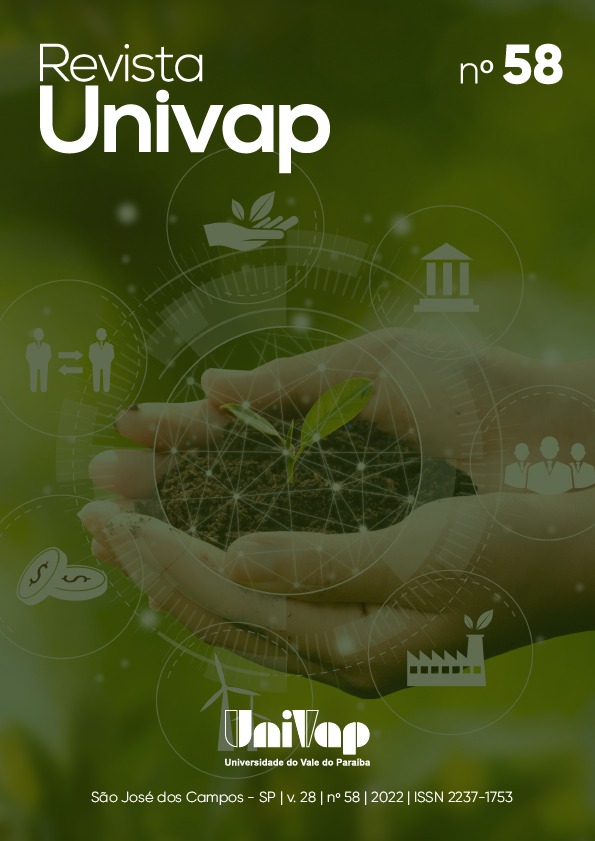DEVELOPMENT OF AN APPLICATION TO ASSIST IN SMALL FARMERS DECISION MAKING
IRRIGATION
DOI:
https://doi.org/10.18066/revistaunivap.v28i58.2643Keywords:
Small farmer, Meteorological sensors, Information systems, Water balance, Low-cost sensorsAbstract
In Brazil, small farmers are responsible for a significant amount of agricultural production. These farmers can benefit from deploying meteorological sensors and the analysis of these data to improve decisions regarding their crops. Soil moisture is a particularly important variable. Considering this, the present project developed and implemented an information system using low-cost sensors and free data repositories to generate and publicize information regarding meteorological data. The collected data are combined with public data on rainfall from a meteorological station in the region of the farms, generating soil water balance information which includes indicators of water surplus and deficit, that are shared through a website or an application for mobile devices. The results of the measured variables allow a deeper knowledge of the local microclimate. The farmer, once given the information, can use it as an element for decisions on crop irrigation. Therefore, the participation of farmers in the development of technological solutions is important. The relevance of an interdisciplinary team approach is evident in the creation of technological solutions that help sustainable environmental management
Downloads
References
Agência Nacional de Águas. (2017). Atlas Irrigação: uso da água na agricultura irrigada. https://arquivos.ana.gov.br/imprensa/publicacoes/AtlasIrrigacaoUsodaAguanaAgriculturaIrrigada.pdf.
Antonacci, E. A. B. (2018). O Projeto de Desenvolvimento Sustentável (PDS) do INCRA em Jundiapeba: regularização fundiária e reforma agrária. Escola de Artes, Ciências e Humanidades, Universidade de São Paulo.
AppInventor (2021). MIT App Inventor. https://appinventor.mit.edu/.
Arduino (2021). Arduino.cc, 2021. https://www.arduino.cc/.
Bormann, H. (2011). Sensitivity analysis of 18 different potential evapotranspiration models to observed climatic change at German climate stations. Climatic Change, 104(3), 729-753. https://doi.org/10.1007/s10584-010-9869-7.
Bosch (2015). BME280 - Combined humidity and pressure sensor - Final data sheet.. https://www.bosch-sensortec.com/products/environmental-sensors/humidity-sensors-bme280/#documents.
Brasil. (2006). LEI nº 11.326 DE 24 DE JULHO DE 2006. Estabelece as diretrizes para a formulação da Política Nacional da Agricultura Familiar e Empreendimentos Familiares Rurais. DOU. http://www.planalto.gov.br/ccivil_03/_Ato2004-2006/2006/Lei/L11326.htm.
Centro Nacional de Monitoramento e Alertas de Desastres Naturais. (2021). Mapa Interativo da Rede Observacional para Monitoramento de Risco de Desastres Naturais do CEMADEN. http://www2.cemaden.gov.br/mapainterativo/#
Centurion, J. F. & Andrioli, I. (2000). Regime hídrico de alguns solos de Jaboticabal. Revista Brasileira de Ciência do Solo. Sociedade Brasileira de Ciência do Solo, 24(4), p. 701-709. http://hdl.handle.net/11449/114556.
ESP8266. (2021). ESP8266 Comunity Forum. https://www.esp8266.com/
Instituto Brasileiro de Geografia e Estatística. (2017) Instituto Brasileiro de Geografia e Estatística. Censo agropecuário: resultados definitivos 2017.
Instituto Nacional de Meteorologia. (2021) Boletim Climatológico São Paulo: Balanço do Outono e Prognóstico para o Inverno 2021.
Laudon, K., & Laudon, J. (2010). Sistemas de Informação Gerenciais (9.ed). Pearson Prentice-Hall.
Monteith JL (1965) Evaporation and environment. In: GT Fogy (ed) The state and movement of water in living organism (pp. 205–234.). Cambridge.
Moreira, E. E. M. (2019). Desenvolvimento de uma miniestação meteorológica de baixo custo baseada na plataforma Arduino. Universidade Federal do Ceará.
Moura, M. S. (2020). Estudo comparativo dos elementos do balanço hídrico climatológico no cerrado para as cidades de Cuiabá e Nova Xavantina (MT). Escola de Artes, Ciências e Humanidades, Universidade de São Paulo.
Nakano. (2021) Sensor Meteorológico. https://github.com/FNakano/CFA/tree/master/projetos/SensorMeteorologico.
Pereira, A.R. (2005). Simplificando o balanço hídrico de Thornthwaite-Mather. Bragantia, 64(2), p. 311-313. DOI: https://doi.org/10.1590/S0006-87052005000200019.
Péres, A. B. (2008). Monitorador de temperatura e umidade do ar. Centro Universitário de Brasília.
Pezente, D. P. (2019). Sistema de Monitoramento Avançado para Cultivo de Hortaliças. SATC Educação e Tecnologia.
Primavesi, A. (2016). Manual do solo vivo (2.ed.). Expressão Popular.
R Core Team. (2020). R: A language and environment for statistical computing. R Foundation for Statistical Computing.
Sabo, P. H. (2011) Modelo de microestação agrometeorológica para monitoramento vitícola. Universidade Estadual de Maringá.
Shafranovich, Y. (2005). Common Format and MIME Type for Comma-Separated Values (CSV) Files. Fremont. https://datatracker.ietf.org/doc/html/rfc4180
Schendel, U. (1967). Vegetationswasserverbrauch und -wasserbedarf (137 pp.). Habilitation, Kiel.
Sistema de Suporte à Decisão na Agropecuária. (2021). Balanço Hídrico Climatológico Decendial. http://sisdagro.inmet.gov.br/sisdagro/app/climatologia/bhclimatologiconormal/index.
Souza, C. F. et al Souza, C. F., Pires, R. C. M., Miranda, D. B. de, & Varallo, A. C. T. (2013). Calibração de sonda FDR e TDR para a estimativa da umidade em dois tipos de solo. IRRIGA, 18(4), p. 597–606. 2013. DOI: 10.15809/irriga.2013v18n4p597.
Thingspeak (2020). Thingspeak.com. Disponível em: https://thingspeak.com/
Thornthwaite, C. W., Mather, J. R. (1957) Instructions and tables for computing potential evapotranspiration and the water balance. No. RESEARCH. Centerton, EUA.
Downloads
Published
How to Cite
Issue
Section
License
Copyright (c) 2022 Revista Univap

This work is licensed under a Creative Commons Attribution 4.0 International License.

This work is licensed under a Creative Commons Attribution 4.0 International.
This license allows others to distribute, remix, tweak, and build upon your work, even commercially, as long as they credit you for the original creation.
http://creativecommons.org/licenses/by/4.0/legalcode


